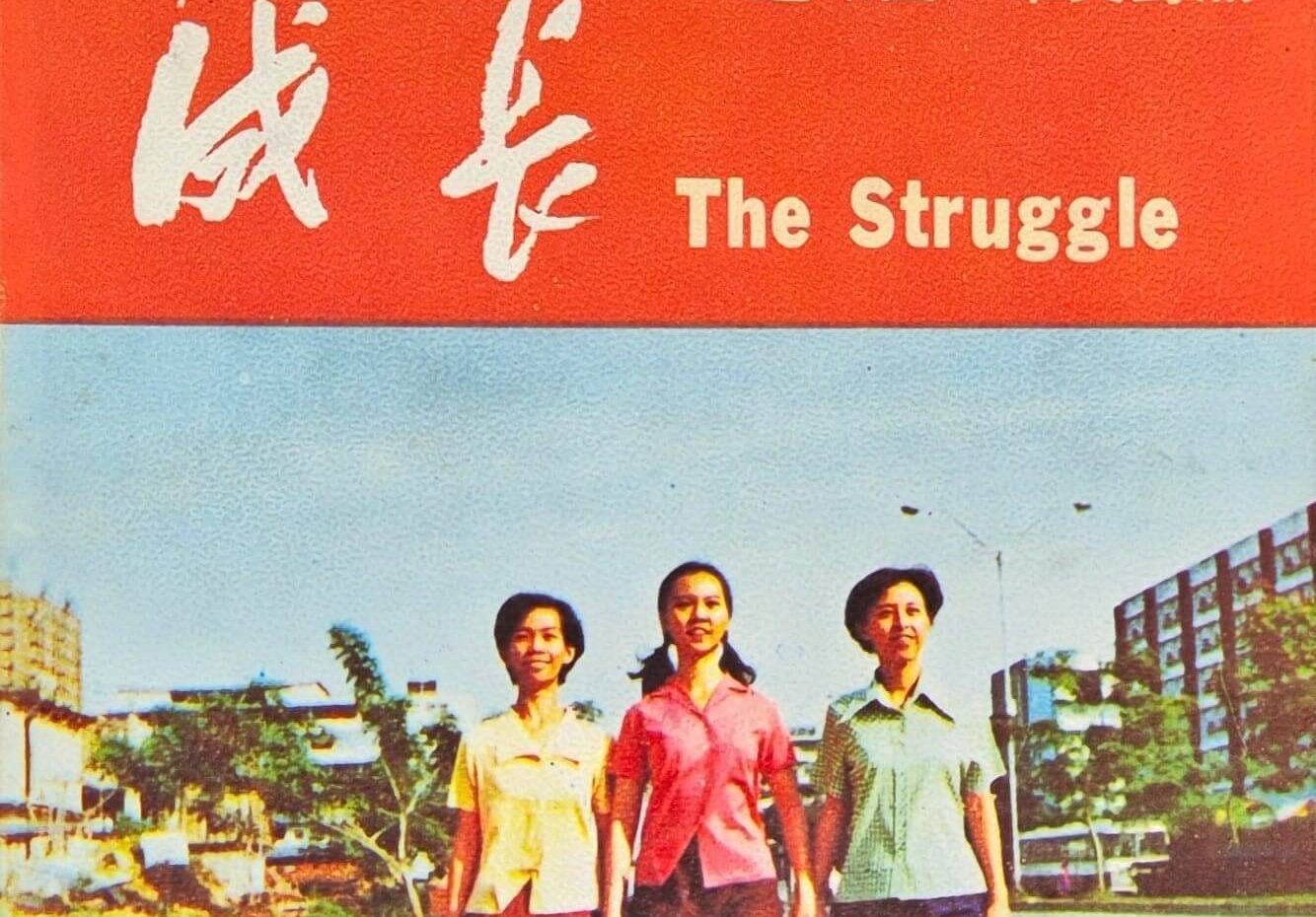新加坡华语戏剧(1959年至今)
家国情怀(1959-1977)
1959年,新加坡成立自治政府,1963年加入马来西亚,1965年新加坡共和国建立。在这个历史时期中,新加坡华语话剧逐渐发展出其具有独自特色的舞台样式。
1959年,政府提出了建造国家剧场的倡议(1963年正式开幕)。艺术剧场也随即于1960年两次演出了由岳野(1920-2001)创作于1948年的《风雨牛车水》,以及本地作者林晨(1919-2004)与陆白的原创独幕剧专场,为建立国家剧场举行义演。

同年,新加坡自治政府文化部举办了第一次戏剧剧本比赛,分四个官方语文小组,得奖作品皆由广播电台改编为广播剧演出。自治政府也以国家剧场基金委员会的名义,分别于1960年和1961年举办了两次年度文化节。这一时期,本地剧作演出非常热烈。1
1965年,文化部召集剧运推动小组,举办“本地独幕剧创作大竞赛”。同年,人民行动党中央文化局也成立了戏剧股,并在维多利亚剧院举行了本地原创独幕剧专场演出。
1965年8月9日,新加坡共和国诞生。同年,郭宝崑(1939-2002)与吴丽娟成立了新加坡表演艺术学院,演出其首部剧作《考验》。1972年,其戏剧训练课程的毕业学员创办了独立的南方艺术团。
儿童剧社于1965年诞生。儿童剧社最初附属于新加坡广播电台华文部,由资深播音员和广播剧推手程茂德(1936–2007)担任导师。1970年,儿童剧社成为独立艺术团体,并组成十多个专业小组进行活动。随着剧社成员年龄的增长,青年剧社也于1971年成立。最盛时期,儿童剧社与青年剧社共有近500多个会员,是1970年代本地最为活跃的华语戏剧表演团体之一。
这个“热火朝天的1970年代”2还见证了更多华语戏剧团体的出现,其中包括实验剧场(1971)、生活剧社(1971)、人民协会文工团戏剧组(1972)、向阳剧社(1972)、春雷文艺研究会(1972)、新加坡青少儿广播演艺组(1973)、大路剧社(1973)、葵花艺术团(1973)、星海艺术研究会(1974)、长风剧社(1974)、长堤文娱团(1974)等。
生机勃勃(1978-1990年代末)
1978年,政府推出“戏剧表演促进计划”,并由文化部于同年开始举办年度(四种语文)的戏剧节。通过这个贯穿整个1980年代华文戏剧演出的重要平台,本地相关剧团推出了一大批原创经典剧作,其中包括《燕飞翔》(艺术剧场,1984)、《茉莉公主》(艺联剧团,1984)、《五个天平座》(南方艺术研究会,1986)等。3
这个时期也见证了更多戏剧团体的成立,如晋江会馆附属戏剧团(1978)、创意戏剧团(1980)、南洋方氏总会戏剧组(1983-1986)、联合报剧团(1984)等。同时,本地也首次出现了华英双语剧团,如实践话剧团(1986)(1996年改名为实践剧场)以及演艺坊(1986-1989)就是其代表。

此外,学校学生包括校友会演剧也掀开了新的篇章,从1970年代开始设立的初级学院的学生演剧活动也开始成为新常态,如国家初级学院在维多利亚剧院公演的独幕剧专场(1976),华中初级学院创立的年度戏剧节公演(始于1976年),南洋初级学院和谈马锡初级学院也先后于1976年和1977年开始其戏剧公演。
这些初级学院的学生演剧活动及其传统给本地华语剧场培养了一批生力军,如当年以林海燕及马炎庆等人开始在华初校友会旗下公演的《符号妈妈》(1991),于1996年发展为“海燕等人”的演剧组合,且一直活跃至今。
在1982年的第四届新加坡艺术节上,本地14个华文戏剧团体联合演出了《小白船》,揭开了1980年代华文戏剧再次兴盛的序幕。4该制作集中了一批新加坡戏剧史上十分活跃的资深华文戏剧工作者,如担任顾问的王秋田(1905-1990)、朱绪(1909-2007),担任主席的刘仁心(1924-2002)、郑民威(1926-2000),担任编导的林晨、周立良(1926-2019)等。该剧由郭宝崑担任执行编导。全剧有近50个跨代演员,加上幕后来自14个剧团的成员,于当年年底在维多利亚剧场演出四场,隔年又增演两场,场场满座。
1984年,本地17个华语剧团再度合作演出韩劳达的新作《乌拉世界》。由华亮、韩劳达和郭宝崑联合导演的这次制作、象征着本地华文戏剧界新一代的崛起。1986年的艺术节再次推出由郭宝崑编导的《㗝呸店》,参与剧团多达23个,包括宗乡会馆和前述四个初级学院的戏剧团体,成为1980年代新加坡华语戏剧联合演出的新高峰。
1991年国家艺术理事会成立,专门从事国家艺术政策的制定与执行工作。同时,1990年,郭宝崑倡导并创办的电力站艺术之家成立。作为新加坡第一个民办艺术中心,电力站为不同语文,不同媒介、尤其是具实验先锋的艺术尝试提供展示的空间。由此,随着年轻一代艺术工作者的成长,1990年代又一次见证了不少新锐艺术团体及其创作的产生,如戏剧盒(1990)、TOY肥料厂戏剧团(后改名为TOY肥料厂制作,1990)、海燕等人(1991)、林仁余和朋友(后改名为意象制作群)(1992)、舞台杂牌军(1994)、老牛剧场(1995),还有曾附属于实践话剧团的十指帮(1996)5等。
多元景象 走向世界(2000年迄今)
滨海艺术中心在2002年开幕,这是新加坡文化艺术发展史上的一个里程碑。2005年,原来位于福康宁山上的戏剧中心也迁入新落成的国家图书馆大厦内。新的戏剧中心拥有一个能容纳615个座位的中型剧场和一个拥有120个观众的黑箱剧场。现代化的演艺条件,给本地各类演艺活动,包括华语剧场在内的演剧朝着进一步专业化的艺术发展方向迈进提供了极为有利的硬件与软件设施。
这时期,本地代表性剧团,如实践剧场、TOY肥料厂制作、戏剧盒、艺术剧场、艺联剧团等,不断推出原创剧目,并实验不同的创作风格。其它剧场,如十指帮(于1999年独立)及纸猴剧坊(2008),致力发展偶戏的形式,前者面向青少年,后者面向儿童及家庭。
尚有成立于2012年的九年剧场,及成立于2017年的避难阶段。前者致力于对经典作品的重新诠释、改编与编篡,同时也部分使用新加坡华族方言演绎本地华语经典;后者强调艺术创作中的跨界合作,是本地目前唯一的实验剧场。
由南洋艺术学院戏剧专业毕业生组成的焦点剧场成立于2010年,并于2016年成为非盈利机构。自2002年起,南洋艺术学院的历届(华语)戏剧专业的毕业演出皆着重将包括本地原创剧目在内的世界戏剧经典作品重新搬上舞台,亦成为本地华语舞台演出多元多彩风景线中不可或缺的一个组成部分。
新世纪以来,在各个国际舞台上,本地剧场作品展现了其独特的内容构成且成熟的艺术风格,显示了新加坡华语剧场多姿多彩的风貌。
2014年,成立于1999年的新加坡艺术节改名为新加坡国际艺术节后重新出发。在2015年的艺术节上便出现了由本地艺术家参与的委约华语原创音乐剧《风画南洋》的制作。两年后,九年剧场获委约将新加坡华文文学作品《画室》进行改编并搬上舞台。从此,每年的新加坡国际艺术节均都有本地华语剧场的委约制作与演出。
同时,21世纪以来,更多的本地华语剧场也更为主动地发起各类戏剧节或是艺术节,如:实践剧场为纪念郭宝崑而举办的《传奇未了》国际合作与交流活动(2002)、郭宝崑节(2003/2012)、M1华文小剧场节(2011/2013/2014/2015/2016/2017)。此外还有戏剧盒的新剧季(2009/2011)等。
由此,本地华语戏剧团体受邀参加海外戏剧节或展演也逐渐成新常态,如戏剧盒参加上海的新加坡季(2007)、TOY肥料厂制作的多部作品在中国的巡演(2003/2010/2013/2014/2017)、九年剧场参加的澳门艺术节(2013),艺联剧团多次参加韩国马山国际戏剧节(2002/2003/2005/2008/2010/2014/2016)和中国山东国际小剧场话剧节(2009/2014)等,以及新加坡艺术剧场先后三次参加中国—东盟戏剧周(2014/2017/2023)。
历经百年,本地华语戏剧从“泊来品”,经过“在地化”洗礼,终于形塑为具有独特风采的新加坡“本土化”的华语剧场艺术。
| 1 | 柯思仁,《戏聚百年:新加坡华文戏剧1913-2013》,页94。 |
| 2 | 同上,页122。 |
| 3 | 同上,页141。 |
| 4 | 同上,页148。 |
| 5 | 同上,页195。 |
方修编,《马华文学大系》(剧运特辑一集)(1919-1942)。新加坡:世界出版社,2000。 | |
方修编,《战后新马文学大系》(戏剧集)。中国:华艺出版社,2001。 | |
杨碧珊,《新加坡戏剧史论》。新加坡:海天文化企业私人有限公司,1993。 | |
周宁编,《东南亚华语戏剧史》。厦门:厦门大学出版社,2007。 | |
柯思仁编著,《戏聚百年:新加坡华文戏剧1913-2013》。新加坡:戏剧盒、新加坡国家博物馆,2013。 | |
詹道玉,《战后初期的新加坡华文戏剧1945-1959》。新加坡:新加坡国立大学中文系、八方文化企业公司,2001。 | |
新加坡艺联剧团编,《天堂,人间,情》。新加坡:艺联剧团,2017。 | |
新加坡艺术剧场编,《新加坡艺术剧场45周年纪念特刊》。新加坡:新加坡艺术剧场,2000。尚包括50周年(2005)、55周年(2010)、60周年(2015)、65周年(2020)等系列纪念特刊。 | |
Fischer-Lichte, Erika, Riley, Josephine and Gissenwehrer, Michae, eds. The Dramatic Touch of Difference: Theatre, Own and Foreign. Tübingen: Gunter Narr Verlag, 1990. | |
Loon, Robin, Kok, Heng Leun et al eds. Theatre: Singapore Chronicles. Singapore: Institute of Policy Studies, Straits Times Press, 2016. | |
Nagata, Yashushi and Chaturvedi, Ravi, eds. Modernization of Asian Theatre: Process & Tradition. Singapore: Springer, 2019. | |
Yu, Weijie. Tradizione e realtà del teatro cinese: dalle origini ai giorni nostri [The tradition and reality of the Chinese theatre: From origin till today]. Milan: International Cultural Exchange, 1995. |










